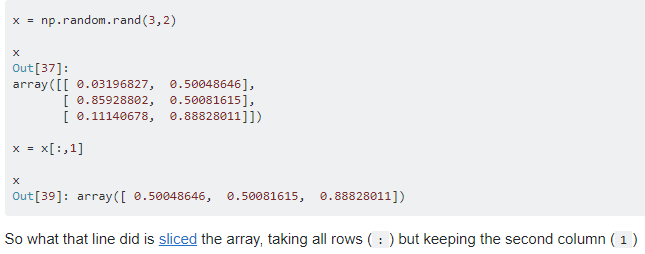Python - Y.shape[n,m];Numpy中的矩阵合并
The shape attribute for numpy arrays returns the dimensions of the array. If Y has n rows and m columns, then Y.shape is (n,m). So Y.shape[0] is n.
In [46]: Y = np.arange(12).reshape(3,4) In [47]: Y Out[47]: array([[ 0, 1, 2, 3], [ 4, 5, 6, 7], [ 8, 9, 10, 11]]) In [48]: Y.shape Out[48]: (3, 4)
#行数 In [49]: Y.shape[0] Out[49]: 3
#列数
In [49]: Y.shape[1]
Out[49]: 4
numpy.full(shape, fill_value, dtype = None, order = ‘C’) : Return a new array with the same shape and type as a given array filled with a fill_value.
# Python Programming illustrating # numpy.full method import numpy as np a = np.full([2, 2], 67, dtype = int) print("\nMatrix a : \n", a) c = np.full([3, 3], 10.1) print("\nMatrix c : \n", c)
output:
Matrix a : [[67 67] [67 67]] Matrix c : [[ 10.1 10.1 10.1] [ 10.1 10.1 10.1] [ 10.1 10.1 10.1]]
x = x[ : , 1]
取x矩阵的第二列的所有行

选择矩阵a的第一列到倒数第二列:
a = a[:, :-1]
删除矩阵a的最后一列:
my_array = np.delete(my_array, -1, axis=1)
删除第一列:
my_array = np.delete(my_array, 0, axis=1)
Numpy中的矩阵合并
列合并/扩展:np.column_stack()
行合并/扩展:np.row_stack()
>>> import numpy as np >>> a = np.arange(9).reshape(3,-1) >>> a array([[0, 1, 2], [3, 4, 5], [6, 7, 8]]) >>> b = np.arange(10, 19).reshape(3, -1) >>> b array([[10, 11, 12], [13, 14, 15], [16, 17, 18]]) >>> top = np.column_stack((a, np.zeros((3,3)))) >>> top array([[ 0., 1., 2., 0., 0., 0.], [ 3., 4., 5., 0., 0., 0.], [ 6., 7., 8., 0., 0., 0.]]) >>> bottom = np.column_stack((np.zeros((3,3)), b)) >>> bottom array([[ 0., 0., 0., 10., 11., 12.], [ 0., 0., 0., 13., 14., 15.], [ 0., 0., 0., 16., 17., 18.]]) >>> np.row_stack((top, bottom)) array([[ 0., 1., 2., 0., 0., 0.], [ 3., 4., 5., 0., 0., 0.], [ 6., 7., 8., 0., 0., 0.], [ 0., 0., 0., 10., 11., 12.], [ 0., 0., 0., 13., 14., 15.], [ 0., 0., 0., 16., 17., 18.]])



